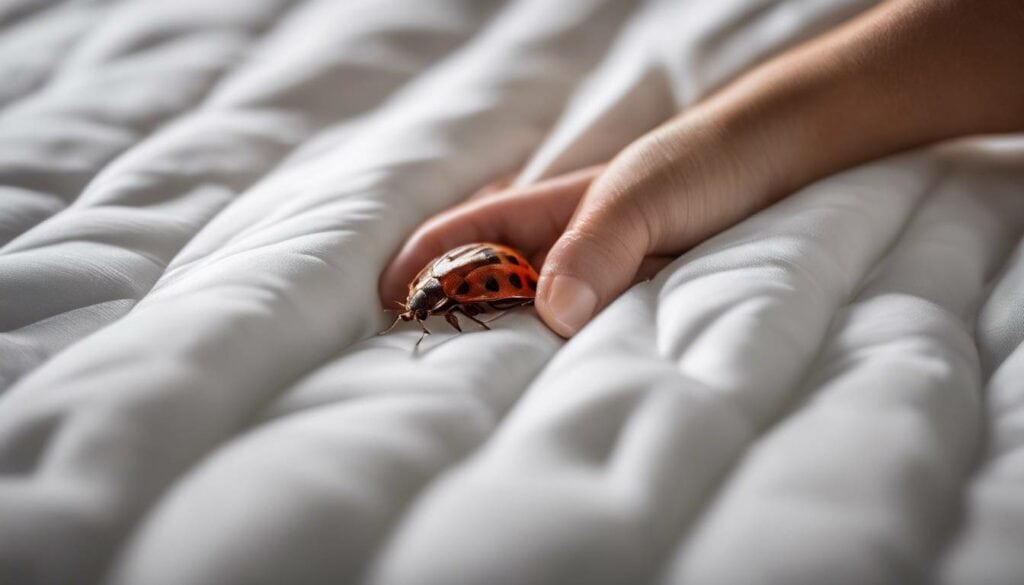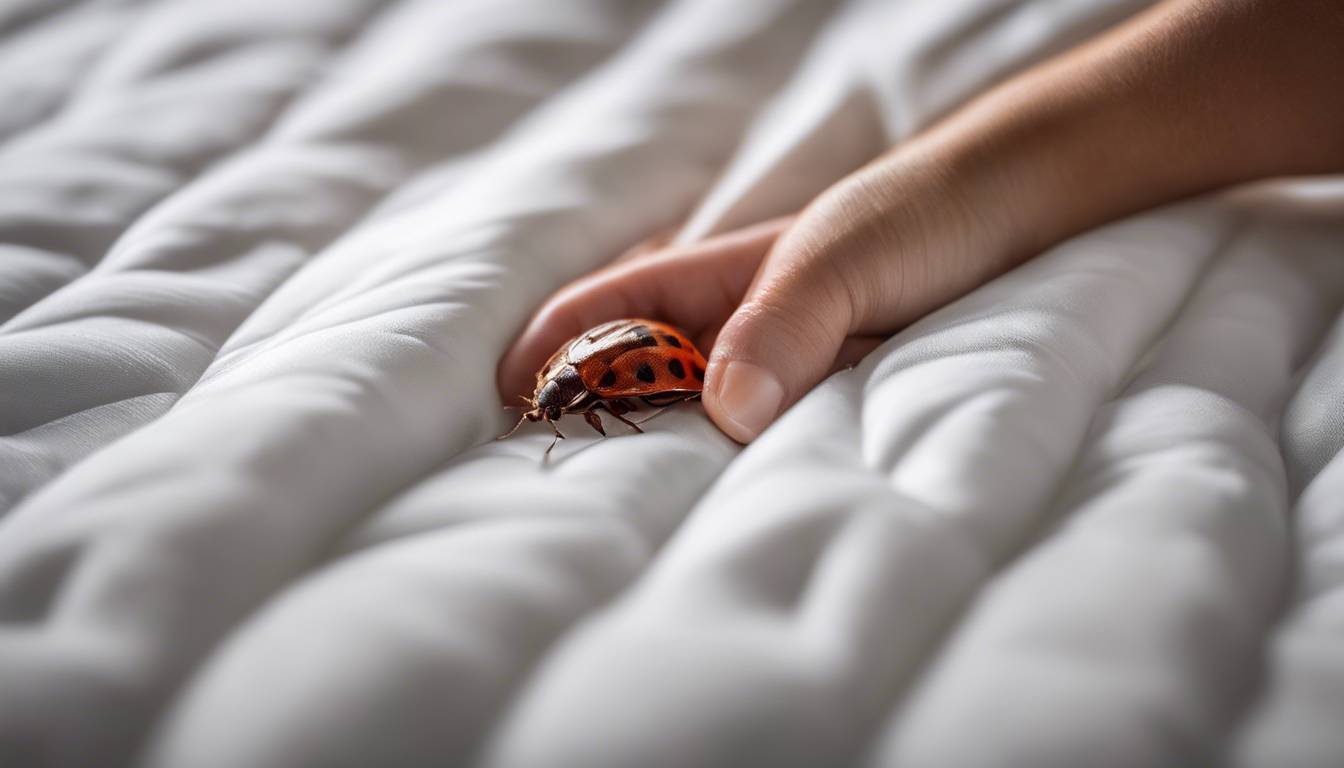As someone who loves a good night’s sleep, discovering unexplained bites without any visible signs of bed bugs was certainly a bewildering experience. This situation can be quite common, as many people wonder how do you get bed bugs when there are no obvious signs. Unable to rest properly, I couldn’t tolerate the disruption to my sleep routine, so I looked deeper into this mystery to regain my much-needed rest properly, I couldn’t tolerate the disruption to my sleep routine, so I looked deeper into this mystery to regain my much-needed rest.
Understanding the puzzle behind your symptoms starts with one fact: bed bug bites can closely mirror other insect bites. Often, red, itchy welts appearing in clusters or lines on sleep-exposed body parts like arms or legs suggest a bed bug’s work, yet other pests may also be to blame. Another crucial aspect left unseen is that not everyone reacts the same to bed bug bites; some might not show any visible signs despite being bitten. These hidden factors can turn your apparent bed bug mystery into a multi-layered riddle. Now, the focus rests on investigating potential reasons for these bites.
If you are experiencing unexplained bug bites but cannot find any signs of bed bugs, it is important to thoroughly inspect your entire home for any potential infestations. This includes checking your mattress, as some people wonder if bed bugs can live in memory foam. Consider consulting a professional exterminator who can conduct a comprehensive inspection and provide the appropriate treatment if necessary. Additionally, consider washing all bedding and clothing in hot water and vacuuming all areas where bed bugs could be hiding to help mitigate the issue.
Identifying Bed Bug Bites
Bed bug bites can be a real nuisance. You wake up one morning, and there they are – red, itchy welts on your skin. These bites can appear in clusters or in a line, typically on areas of the body that are exposed while you sleep, such as your arms, shoulders, neck, or legs. They may resemble other insect bites like those from mosquitoes or fleas, but there are some distinctive features that can help you distinguish them.
The appearance of bed bug bites varies from person to person. Some individuals may develop an immediate reaction to the bites, while others might not show any signs at all. It’s estimated that around 30% of people do not have a visible reaction to bed bug bites, so the absence of visible welts doesn’t necessarily rule out the possibility of a bed bug infestation.
If you notice these red, itchy welts appearing in clusters or lines on areas of your body that were exposed during sleep, it’s a strong indication that bed bugs could be the culprits. Additionally, the timing of the appearance of these bites after being bitten can also provide insight. Bed bug bites can take anywhere from 1 to 14 days to become noticeable after being bitten.
It’s important to note that not all people react the same way to bed bug bites, so don’t dismiss the possibility of a bed bug infestation just because you or someone else in your household isn’t showing any visible signs of being bitten.
Understanding the distinct characteristics of bed bug bites is crucial in identifying and addressing potential infestations before they become more severe.
Let’s now unravel the mystery behind the symptoms further by exploring potential reasons for bites without visible bugs.
Potential Reasons for Bites Without Visible Bugs
If you’ve been noticing unexplained bites but can’t seem to find any signs of bed bugs, don’t worry. Several other possibilities could be causing those mysterious bites. Let’s explore each one to help you understand what may be happening.
Other Insects
It’s not just bed bugs that can leave you with itchy, annoying bites. Fleas, mites, and mosquitoes are also common culprits, leaving similar marks on your skin, making it difficult to discern their source. However, each of these insects requires a different approach when it comes to treatment and prevention.
Fleas are often brought into homes by pets and thrive in carpets and furniture, especially in warmer climates. They bite humans and animals and can cause reddish spots on the skin with a characteristic red halo around the center. Mites, on the other hand, are tiny creatures that thrive in bedding, furniture, or carpet and can cause skin irritation leading to small red bumps. Mosquitoes are known for leaving raised, itchy welts after they feed on blood.
Skin Conditions
Sometimes, innocent skin conditions like eczema or allergies can mimic the appearance of insect bites, adding to the confusion about what might be causing the symptoms.
People with eczema have inflamed, red, dry, and itchy skin that may appear similar to insect bites. Allergies can also lead to redness and itching that resembles reactions to bug bites, further complicating the process of identifying the true cause.
Psychological Factors
In some cases, people may experience psychosomatic symptoms, where they perceive a sensation of being bitten despite no physical evidence of actual bites present. This can result in increased irritation and skin discomfort due to a perceived feeling of being bitten.
The power of the mind is remarkable. When someone believes they are being bitten by something invisible or unreal, it can lead to physical sensations such as itching or pain even in the absence of any external cause. Anxiety or stress can also exacerbate this through a heightened state of awareness towards bodily sensations.
Understanding these potential reasons is essential for effectively addressing your symptoms and determining the appropriate course of action to take for relief and comfort. By considering these factors, you can better equip yourself to identify the true cause behind your mysterious bites and take steps toward finding a suitable solution.
As we unravel the enigma behind unexplained bites, honing your inspection strategy becomes imperative in uncovering the hidden truths within your living spaces.
Improving your Inspection Strategy
When dealing with bed bug infestations, a thorough visual examination is crucial for identifying these elusive pests. Begin by meticulously inspecting the mattress seams, bed frames, and nearby furniture using a flashlight and a magnifying glass. Although bed bugs are adept at hiding during the day, paying close attention to these areas can help in detecting signs of an infestation.
Another essential aspect of the inspection process involves looking for tiny specks or stains that could indicate bed bug activity. These signs may include tiny eggs, shed skins, or even live bugs. It’s also important to check your vacuum cleaner, as some people wonder can bed bugs live in your vacuum cleaner. Spotting these indicators can confirm suspicions and prompt quick action to address the infestation. Remember, early detection is critical in preventing an infestation from spreading further.
In addition to detailed visual inspections, incorporating interception devices can assist in both trapping and confirming the presence of bed bugs. Placing bed bug interceptors under bed legs not only traps these pests but also acts as a preventive measure by reducing the likelihood of them accessing the bed. This can significantly help minimize the impact of bites and potentially control the spread of an infestation.
Think of these interceptors as early warning systems that provide valuable evidence of bed bug activity. By capturing these pests before they reach your mattress or furniture, interception devices play a vital role in pinpointing the presence of bed bugs and determining the extent of an infestation.
By carefully employing these inspection tactics, you can increase your chances of detecting bed bugs early on, allowing for timely intervention and mitigation of potential infestations.
With these enhanced inspection strategies at your disposal, it’s time to turn our attention to understanding the various health reactions associated with bed bug bites.
Health Reactions to Bed Bug Bites
Bed bug bites can cause a range of reactions, varying from person to person. While some individuals may experience mild itching and skin redness, others might develop severe allergic responses. For this reason, it’s vital to not only monitor any unusual or persistent symptoms but also seek medical advice if necessary.
For approximately 30% of people, bed bug bites don’t produce any visible reaction at all. This means that even if you’re not seeing any physical signs on your skin, it doesn’t automatically rule out the possibility of bed bug bites. Furthermore, the time it takes for bed bug bites to appear after being bitten can range from 1 to 14 days, adding another layer of complexity to identifying the source of your symptoms.
It’s essential to emphasize that different individuals react differently to these bites, which can manifest as reddened areas or small, raised welts that resemble mosquito bites.
Let’s consider an example: Sarah wakes up with what look like mosquito bites on her knees and elbows. These bites then turn into smaller, red dots after a few days before fading away. Sarah initially thinks nothing of it but finds herself waking up with new clusters of bites every day. She begins feeling intense psychological distress due to the anxiety and discomfort associated with the possibility of a bed bug infestation.
Conversely, John, who shares a bedroom with Sarah, does not seem bothered by any symptoms despite sleeping in the same room. This further highlights the variabilities in individual reactions to bed bug bites. Even more alarming is the fact that approximately 10% of people do not react to bed bug bites at all, making it even more challenging to identify an infestation based solely on personal health reactions.
It’s worth noting that approximately 3% of individuals can develop severe allergic reactions to bed bug bites, underscoring the importance of seeking professional medical advice if you experience unusually severe symptoms.
Understanding how your body may physically respond to bed bug bites is essential not only for identifying a potential infestation but also for managing any health concerns related to these pests.
With insights into the physical manifestations of bed bug bites fresh in mind, let’s now turn our attention toward a comprehensive evaluation of mattresses and furniture to aid in detecting and addressing possible infestations.
Thorough Mattress and Furniture Assessment
The first step to ensuring your home is free from bed bugs is conducting a thorough inspection, particularly focusing on the areas where bed bugs are likely to hide. When it comes to your mattress, the seams, tags, and any tufts should be checked diligently, as these are prime spots for bed bugs to take up residence. It’s important to also inspect the box spring, headboard, and footboard which are often overlooked but can be hotspots for bed bug activity.
During your inspection, keep an eye out for rusty or reddish stains on the mattress and linens; these could indicate crushed bed bugs. Additionally, be vigilant in checking for dark spots which could be bed bug excrement. If you’ve used a vacuum for cleaning, you might wonder how to clean your vacuum after bed bugs. Furthermore, don’t underestimate the importance of closely examining upholstered furniture like sofas and chairs. The seams, underneath cushions, and even inside the frames are all potential hiding spots for these elusive pests.
A Comprehensive Inspection Checklist Here’s a checklist you can use when assessing your mattress and furniture:
Area to Inspect |
Potential Signs of Infestation |
|---|---|
Mattress Seams and Tufts |
Live bed bugs or their exoskeletons |
Upholstered Furniture |
Small white eggs or translucent shells |
Wooden Furniture |
Tiny black specks (bed bug excrement) |
Electrical Outlets Near Bed |
Dark spots that might indicate bed bug feces |
It’s important to note that spotting these signs doesn’t necessarily mean there’s a full-blown infestation, but early detection is key in preventing an infestation from becoming widespread.
For instance, if you suspect the presence of bed bugs, acting promptly can save you from dealing with a larger problem down the road. One effective method is using mattress encasements, which not only act as a protective barrier but also make future inspections much easier.
Now that we understand the vital role of thorough mattress and furniture assessment in detecting potential bed bug infestations, let’s explore proactive steps to minimize the risk of infestations in these areas.
Approaches to Deal with Bites When No Bugs Are Found
It can be disheartening to find yourself dealing with bug bites but not have any bugs to show for it. The first thing you should do is take a deep breath and remain calm. Then you can move on by considering these approaches to deal with the situation:
Consult a Pest Control Professional
The best way to handle this troubling scenario is to seek the expertise of a licensed pest control professional. They can carry out a comprehensive inspection of your home, putting their trained eye to every corner. If necessary, they will then implement targeted treatments to address any potential sources of the bites you’re experiencing. A professional will know exactly what signs to look for and where, making it far more likely that any pests or infestations will be found and dealt with properly.
Bedding and Clothing Treatment
While waiting for your appointment with the pest control professional, take proactive steps to potentially eliminate any unseen pests or their eggs. One effective method is to wash and heat-dry all bedding, linens, and clothing on high settings. This process has the potential to exterminate any hidden pests that have made a home in your fabrics. Additionally, vacuuming potentially infested areas can also help by removing any stray pests or eggs.
Think of this as giving your clothes and bedding a spa day! High heat is like a relaxing sauna that makes things all better again. Taking these measures will not only help in dealing with any hidden pests but also give you some peace of mind knowing that you’re taking active steps toward a solution.
By combining these two approaches, consulting a pest control expert and treating your bedding and clothing, you’ll be taking proactive steps toward identifying and addressing the cause of those mysterious bites. It’s always important to address these issues head-on, and with these methods, you’ll be well on your way to resolving the mystery behind your symptoms.
Dealing with suspected bug bites can indeed be distressing, but being proactive about seeking professional help and taking care of your belongings can bring relief and clarity in identifying the culprit behind the bites.






